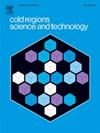A simple lab screening test to evaluate ice adhesion
IF 3.8
2区 工程技术
Q1 ENGINEERING, CIVIL
引用次数: 0
Abstract
Ice formation is a major problem for many sectors such as aeronautics, power generation, maritime, communications, etc. and therefore, there is a growing demand for anti-icing surface modification technologies.
Being able to compare and evaluate these materials at the laboratory scale is a challenge for which a unified response has not yet been given. There are no standards for evaluating icephobicity despite the fact that there are numerous studies focused on the influence of the surface topography on the wetting behavior. In addition, several testing options have been published both for the evaluation of ice accretion, mainly focused on ice wind tunnels (IWT), and on ice to substrate adhesion, as for instance the zero degree cone test, DLST, Cantilever, centrifugal tests, etc.
This article describes a method developed to carry out a simple screening evaluation of ice adhesion by the double lap shear test (DLST) method. This technique can provide qualitative ice adhesion information and is commonly available in research laboratories. Moreover, it does not require icing wing tunnel testing. Its ease of execution and reproducibility makes it a useful tool for a first stage evaluation of anti-icing surfaces despite the fact that ice is formed under static conditions. Various materials and surface finished surfaces with different degree of ice adhesion strength were evaluated and were also tested in a centrifugal adhesion test with ice accreted in an IWT. The results showed that the DLST is valid for ice adhesion classification of materials, but shows limitations for those superhydrophobic materials that are in the Cassie-Baxter state.
一个简单的实验室筛选测试来评估冰的粘附性
冰的形成是航空、发电、海事、通信等许多领域的主要问题,因此,对防冰表面改性技术的需求日益增长。能够在实验室规模上比较和评估这些材料是一项挑战,对此尚未给出统一的回应。尽管有大量的研究集中在表面形貌对润湿行为的影响上,但目前尚无评价憎冰性的标准。此外,已经发布了几种测试选项,用于评估冰的增加,主要集中在冰风洞(IWT)上,以及冰与基底的粘附性,例如零度锥试验、DLST、悬臂、离心试验等。本文描述了一种开发的方法,通过双搭接剪切试验(DLST)方法对冰粘附性进行简单的筛选评估。这种技术可以提供定性的冰粘附信息,通常在研究实验室中可用。此外,它不需要结冰机翼隧道测试。尽管冰是在静态条件下形成的,但其易于执行和可重复性使其成为抗冰表面第一阶段评估的有用工具。评估了不同程度的冰粘附强度的各种材料和表面加工表面,并在IWT中进行了离心粘附试验。结果表明,DLST对材料的冰粘附分类是有效的,但对Cassie-Baxter状态下的超疏水材料存在局限性。
本文章由计算机程序翻译,如有差异,请以英文原文为准。
求助全文
约1分钟内获得全文
求助全文
来源期刊

Cold Regions Science and Technology
工程技术-地球科学综合
CiteScore
7.40
自引率
12.20%
发文量
209
审稿时长
4.9 months
期刊介绍:
Cold Regions Science and Technology is an international journal dealing with the science and technical problems of cold environments in both the polar regions and more temperate locations. It includes fundamental aspects of cryospheric sciences which have applications for cold regions problems as well as engineering topics which relate to the cryosphere.
Emphasis is given to applied science with broad coverage of the physical and mechanical aspects of ice (including glaciers and sea ice), snow and snow avalanches, ice-water systems, ice-bonded soils and permafrost.
Relevant aspects of Earth science, materials science, offshore and river ice engineering are also of primary interest. These include icing of ships and structures as well as trafficability in cold environments. Technological advances for cold regions in research, development, and engineering practice are relevant to the journal. Theoretical papers must include a detailed discussion of the potential application of the theory to address cold regions problems. The journal serves a wide range of specialists, providing a medium for interdisciplinary communication and a convenient source of reference.
 求助内容:
求助内容: 应助结果提醒方式:
应助结果提醒方式:


